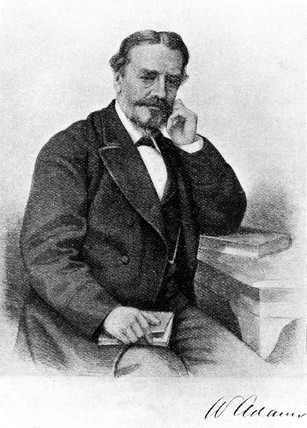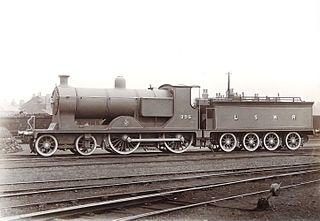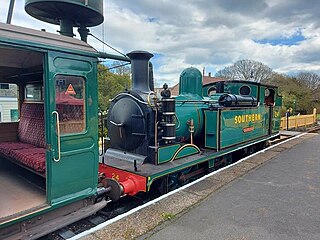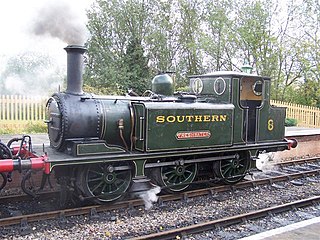
The British Railways standard class 2 2-6-2T was a class of steam locomotive, one of the standard classes of the 1950s.

The LSWR/SR H15 class was a class of 2-cylinder 4-6-0 steam locomotives designed by Robert Urie for mixed-traffic duties on the LSWR. Further batches were constructed by Richard Maunsell for the Southern Railway after 1923. They were given the nickname of "Junior King Arthur" due to the size of their driving wheels, the S15 and their N15 cousins had driving wheels which had a diameter of 5 foot and 7 inches and 6 foot and 7 inches respectively.

The London, Brighton and South Coast Railway (LB&SCR) A1 class is a class of British 0-6-0T steam locomotive. Designed by William Stroudley, 50 members of the class were built in 1872 and between 1874 and 1880, all at Brighton railway works. The class has received several nicknames, initially being known as "Rooters" by their south London crews. However, the engines were more famously known as "Terriers" on account of the distinctive 'bark' of the exhaust beat. Later in their careers, some engines were known as "Hayling Billy" on account of their work on the Hayling Island branch line. A pub of this name on the island was briefly home to the engine which is now No. W8 Freshwater.

The LSWR M7 class is a class of 0-4-4T passenger tank locomotive built between 1897 and 1911. The class was designed by Dugald Drummond for use on the intensive London network of the London and South Western Railway (LSWR), and performed well in such tasks. Because of their utility, 105 were built and the class went through several modifications over five production batches. For this reason there were detail variations such as frame length. Many of the class were fitted with push-pull operation gear that enabled efficient use on branch line duties without the need to change to the other end of its train at the end of a journey.

The LSWR O2 class is a class of 0-4-4T steam locomotive designed for the London and South Western Railway by William Adams. Sixty were constructed during the late nineteenth century. They were also the last steam engines to work on the Isle of Wight, with the final two being withdrawn in 1967. One has been preserved and is operational.

The SR USA class are some ex-United States Army Transportation Corps S100 Class steam locomotives purchased and adapted by the Southern Railway (SR) after the end of the Second World War to replace the LSWR B4 class then working in Southampton Docks. SR staff nicknamed them "Yank Tanks".

The London and South Western Railway L12 class was a class of 20 4-4-0 steam locomotives designed for express passenger work by Dugald Drummond. They were introduced to the London and South Western Railway network in 1904. Despite the class being an unremarkable continuation of the Drummond lineage, one member was involved in the infamous Salisbury rail crash in June 1906. None of the class survived into preservation after their brief career in British Railways ownership.

The London and South Western Railway K10 Class was a class of 40 4-4-0 steam locomotives designed for mixed traffic work. They were introduced on the London and South Western Railway in 1901 and 1902 to the design of Dugald Drummond, where they earned the nickname "Small Hoppers".

William Adams was an English railway engineer. He was the Locomotive Superintendent of the North London Railway from 1858 to 1873; the Great Eastern Railway from 1873 until 1878 and the London and South Western Railway from then until his retirement in 1895. He is best known for his locomotives featuring the Adams bogie, a device with lateral centring springs to improve high-speed stability. He should not be mistaken for William Bridges Adams (1797–1872) a locomotive engineer who, confusingly, invented the Adams axle – a radial axle that William Adams incorporated in designs for the London and South Western Railway.

The London and South Western Railway T9 class is a class of 66 4-4-0 steam locomotive designed for express passenger work by Dugald Drummond and introduced to services on the LSWR in 1899. One example has been preserved after British Railways ownership. They were given the nickname of "Greyhounds" due to their speed, up to 85 miles per hour (137 km/h), and reliability.
The Lyme Regis branch line was a railway branch line connecting the seaside town of Lyme Regis with the main line railway network at Axminster, running through picturesque rural countryside on the Dorset - Devon border.

The LSWR 46 Class was a class of 4-4-0 passenger tank locomotive designed by William Adams for the London and South Western Railway. Later rebuilt to 4-4-2T, no examples have been preserved.

The LSWR G6 class was an 0-6-0T tank locomotive designed by William Adams for the London and South Western Railway.

The LSWR Class S11 was a class of 10 4-4-0 steam locomotives designed for express passenger work by Dugald Drummond. They were introduced to services on the London and South Western Railway in 1903. None of the class survived into preservation after their brief career in British Railways ownership.

The LSWR Class T14 was a class of ten 4-6-0 locomotives designed by Dugald Drummond for express passenger use on the London and South Western Railway and constructed at Eastleigh in 1911–12.

The LSWR G14 class was a class of 4-6-0 locomotive designed by Dugald Drummond for the London and South Western Railway.

The LSWR P14 class was a class of 4-6-0 locomotive designed by Dugald Drummond for the London and South Western Railway.

The LSWR D15 class 4-4-0 was the last steam locomotive design by Dugald Drummond for the London and South Western Railway in 1912. By 1912, Dugald Drummond had built several classes of unsuccessful 4-6-0 express passenger locomotives. The result of these failures was that when he designed what was to be his last class in 1911, a new 4-4-0 design emerged from Eastleigh Works in February 1912, with what was to be the first of his D15 class.

W24 Calbourne is an example of the Adams LSWR O2 class 0-4-4T, which is based at the Isle of Wight Steam Railway. It is the sole survivor of its class.

W8 Freshwater is a Stroudley A1X Terrier class 0-6-0T steam locomotive, which is based at the Isle of Wight Steam Railway.




















